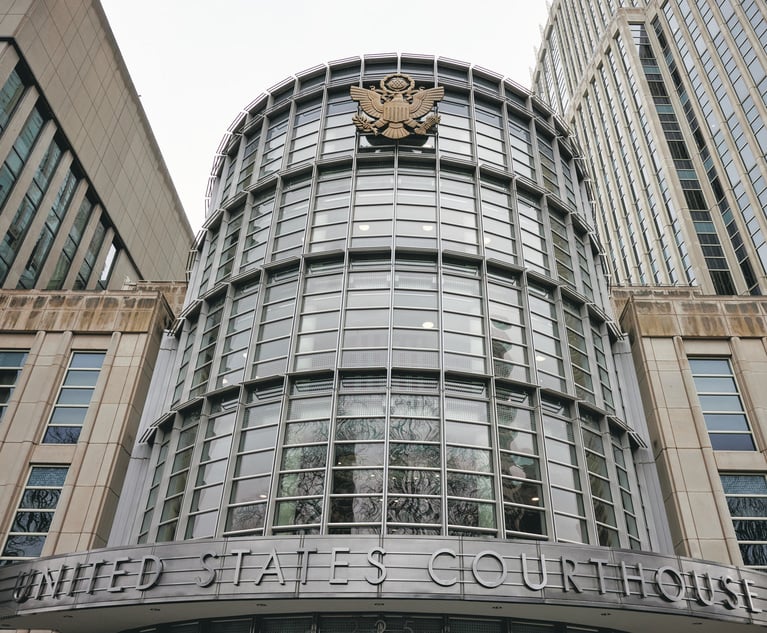New York State Class Actions: Taking a Stand for Labor
Thomas A. Dickerson writes: I have been writing about New York state class actions under CPLR Article 9 since 1979, and although the proper utilization of Article 9 has on occasion been problematic, there are moments when decisions can, indeed, be inspiring. The First Department's decision in 'Gold v. New York Life Insurance Company' is one of them.
August 10, 2017 at 02:02 PM
22 minute read
I have been writing about New York state class actions under CPLR Article 9 since 1979, see Dickerson, “New York State Class Actions: Make It Work—Fulfill the Promise,” 74.2 Albany L.R. 711 n.1, and although the proper utilization of Article 9 has on occasion been problematic, there are moments when decisions can, indeed, be inspiring. The First Department's decision in Gold v. New York Life Insurance Company is one of them. 2017 N.Y. App. Div. LEXIS 5627 (1st Dept. 2017). In fact, in terms of courage and thoughtful analysis in both majority and dissenting opinions, Gold ranks very close to the superb decision of the Court of Appeals in Borden v. 400 East 55th Street Associates allowing tenants to sue as a class if they waived the penalty provisions of the statutes (e.g., Rent Stabilization Law) under which they brought suit, thereby circumventing the prohibitions of CPLR 901(b). 24 N.Y.3d 382 (2014); see Dickerson & Duffy, “'Borden': a Welcome Sea Change on New York State Class Actions,” N.Y.L.J., (June 29, 2015, p. 4); Dickerson, Austin & Zucco, New York State Class Actions: Making It Work—Fulfilling the Promise: Some Positive Developments and Why CPLR 901(b) Should Be Repealed,” 77.1 Albany L.R. 59 (2014).
Allowing class members to “waive the penalty” had already become accepted practice in class actions brought by consumers, employees and others. See, e.g., Cox v. Microsoft, 8 A.D.3d 39 (1st Dept. 2004); Ridge Meadows Homeowners' Ass. v. Tara Dev., 242 A.D. 2d 947 (4th Dept. 1997); Super Glue v. Avis Rent A Car System, 132 A.D.2d 604, 606 (2d Dept. 1987); Pesantz v. Boyle Environmental Services, , 251 A.D.2d 11 (1st Dept. 1998); Krebs v. Canyon Club, 22 Misc. 3d 1125 (West. Sup. 2009); Pires v. Bowery Presents, 44 Misc. 3d 704 (N.Y. Sup. 2014) (Arts and Cultural Affairs Law 25.30(1)(c)).
It is fair to state that after Borden Article 9 of the CPLR became more readily available to consumers, tenants and employees as a useful procedural device to aggregate and prosecute similar claims.
Enter 'Concepcion'
At the same time there were several decisions by the U.S. Supreme Court which sought to reduce, if not, eliminate the use of the class action device by the very groups which our Court of Appeals and Appellate Divisions sought to empower. As for consumers, a series of decisions by the U.S. Supreme Court relying upon the Federal Arbitration Act (FAA) made it clear that mandatory arbitration clauses and class action and class arbitration waivers in consumer contracts were to be enforced. See, e.g., Green Tree Financial v. Bassel, 539 U.S. 444 (2003) (arbitrator decides whether arbitration agreement prohibits class arbitrations); Stolt-Nielsen v. AnimalFeeds International, 130 S. Ct. 1758 (2010) (“It follows that a party may not be compelled under the FAA to submit to class arbitration unless there is a contractual basis for concluding that the party agreed to do so.”); AT&T Mobility v. Concepcion, 131 S. Ct. 1740 (2011)(abrogating Discover Bank v. Superior Court to the effect that consumer contracts containing clauses prohibiting class actions or class arbitrations were void as against public policy); American Express v. Italian Colors Restaurant, 133 S. Ct. 234 (2013) (rejecting argument that class arbitration was necessary to prosecute claims “that might otherwise slip through the legal system”); and DirecTV v. Imburgia, 136 S. Ct. 463 (2015) (“California's interpretation of the phrase 'law of your state' does not place arbitration contracts 'on equal footing with all other contracts'.”).
Remedies Extinguished
One need only read Justice Ruth Bader Ginsburg's dissent in DirecTV and the New York Times article cited therein to understand that meaningful consumer remedies have nearly been extinguished. See Silver-Greenberg and Corkey, “In Arbitration, a 'Privatization of the Justice System',” New York Times (Nov. 1, 2015) (“By inserting individual arbitration clauses into a soaring number of consumer and employment contracts, companies [have] devised a way to circumvent the courts and bar people from joining together in class-action lawsuits, realistically the only tool citizens have to fight illegal or deceitful business practice.”); see also Silver-Greenberg and Gebeloff, “Arbitration Everywhere, Stacking the Deck of Justice” New York Times (Oct. 31, 2015); The Editorial Board, “Arbitrating Disputes, Denying Justice,” New York Times (Nov. 7, 2015); Arbitration Study, Report to Congress, pursuant to Dodd-Frank Wall Street Reform and Consumer Protection Act 1028(a) (March 2015), published by the federal Consumer Financial Protection Board, and its recent rule-making seeking to prohibit financial companies from using class action waivers in their arbitration agreements entered into after the effective date of the rule. The final rule will be codified at 12 C.F.R. part 1040 to Chapter X in Title 12 of the Code of Federal Regulations. See The Editorial Board, “Forcing Banks to Fight Fair,” New York Times (July 15, 2017) (“A powerful rule finalized last week by the Consumer Financial Protection Bureau will allow consumers to join together in class action lawsuits against banks, credit card companies and other lenders over price gouging, predatory lending, abusive loan terms and other mistreatment”).
Circumventing 'Concepcion'
As noted by the California Supreme Court in Sanchez v. Valencia Holding Company, 61 Cal. 4th 899 (Cal. Sup. 2015), Concepcion “reaffirmed that the FAA does not preempt 'generally applicable contract defenses, such as fraud, duress or unconscionability' … . Under the FAA, these defenses may provide grounds for invalidating an arbitration agreement if they are enforced evenhandedly and do not 'interfere with fundamental attributes of arbitration'.” And, indeed, there are ways in which to circumvent Concepcion depending upon the facts of each case. See Dickerson & Chambers, “Challenging 'Concepcion' in New York State Courts,” N.Y.L.J. (Dec. 29, 2015); Dickerson, “Class Actions: The Law of 50 States,” Law Journal Press, §4.03[5].
What About Employees?
On Oct. 2, 2017 the Supreme Court is scheduled to hear oral argument regarding the legality of arbitration agreements in employment contracts requiring workers to waive their rights to sue in collective or class actions. In fact, there is now an even split between six U.S. Courts of Appeals that have considered the enforceability of In re D.R. Horton (Horton I), 357 NLRB No. 184 (Jan. 3, 2012), which held that forcing an employee to waive his or her right to sue in a collective or class action is an unfair labor practice under the National Labor Relations Act. See NLRB v. Alternative Entertainment, 2017 U.S. App. LEXIS 9272 (6th Cir. May 26, 2017), Lewis v. Epic Systems, 823 F.3d 1147 (7th Cir. 2016) cert. granted 137 S. Ct. 809 (2017), and Morris v. Ernst & Young, 834 F.2d 975 (9th Cir. 975), cert. granted 137 S. Ct. 809 (2017) (all upholding Horton I); Sutherland v. Ernst & Young, 726 F.3d 290 (2d Cir. 2013), Murphy Oil USA v. NLRB, 808 F.3d 1013 (5th Cir. 2015), cert. granted 137 S. Ct. 809 (2017), and Owen v. Bristol Care, 702 F.3d 1050 (8th Cir. 2013) (all rejecting Horton I).
First Department Joins the Fray
In considered and very well written opinions by both the majority and the dissent in Gold v. New York Life Insurance, the Appellate Division, First Department,
This content has been archived. It is available through our partners, LexisNexis® and Bloomberg Law.
To view this content, please continue to their sites.
Not a Lexis Subscriber?
Subscribe Now
Not a Bloomberg Law Subscriber?
Subscribe Now
NOT FOR REPRINT
© 2025 ALM Global, LLC, All Rights Reserved. Request academic re-use from www.copyright.com. All other uses, submit a request to [email protected]. For more information visit Asset & Logo Licensing.
You Might Like
View All
Big Tech and Internet Companies Slammed With Consumer Class Actions in December

GE Agrees to $362.5M Deal to End Shareholder Claims Over Power, Insurance Risks
2 minute read
'No Evidence'?: Big Law Firms Defend Academic Publishers in EDNY Antitrust Case
3 minute read
'Substantive Deficiencies': Judge Grants Big Law Motion Dismissing Ivy League Price-Fixing Claims
3 minute readTrending Stories
- 1Family Court 2024 Roundup: Part I
- 2In-House Lawyers Are Focused on Employment and Cybersecurity Disputes, But Looking Out for Conflict Over AI
- 3A Simple 'Trial Lawyer' Goes to the Supreme Court
- 4Clifford Chance Adds Skadden Rainmaker in London
- 5Latham, Kirkland and Paul Weiss Climb UK M&A Rankings
Who Got The Work
J. Brugh Lower of Gibbons has entered an appearance for industrial equipment supplier Devco Corporation in a pending trademark infringement lawsuit. The suit, accusing the defendant of selling knock-off Graco products, was filed Dec. 18 in New Jersey District Court by Rivkin Radler on behalf of Graco Inc. and Graco Minnesota. The case, assigned to U.S. District Judge Zahid N. Quraishi, is 3:24-cv-11294, Graco Inc. et al v. Devco Corporation.
Who Got The Work
Rebecca Maller-Stein and Kent A. Yalowitz of Arnold & Porter Kaye Scholer have entered their appearances for Hanaco Venture Capital and its executives, Lior Prosor and David Frankel, in a pending securities lawsuit. The action, filed on Dec. 24 in New York Southern District Court by Zell, Aron & Co. on behalf of Goldeneye Advisors, accuses the defendants of negligently and fraudulently managing the plaintiff's $1 million investment. The case, assigned to U.S. District Judge Vernon S. Broderick, is 1:24-cv-09918, Goldeneye Advisors, LLC v. Hanaco Venture Capital, Ltd. et al.
Who Got The Work
Attorneys from A&O Shearman has stepped in as defense counsel for Toronto-Dominion Bank and other defendants in a pending securities class action. The suit, filed Dec. 11 in New York Southern District Court by Bleichmar Fonti & Auld, accuses the defendants of concealing the bank's 'pervasive' deficiencies in regards to its compliance with the Bank Secrecy Act and the quality of its anti-money laundering controls. The case, assigned to U.S. District Judge Arun Subramanian, is 1:24-cv-09445, Gonzalez v. The Toronto-Dominion Bank et al.
Who Got The Work
Crown Castle International, a Pennsylvania company providing shared communications infrastructure, has turned to Luke D. Wolf of Gordon Rees Scully Mansukhani to fend off a pending breach-of-contract lawsuit. The court action, filed Nov. 25 in Michigan Eastern District Court by Hooper Hathaway PC on behalf of The Town Residences LLC, accuses Crown Castle of failing to transfer approximately $30,000 in utility payments from T-Mobile in breach of a roof-top lease and assignment agreement. The case, assigned to U.S. District Judge Susan K. Declercq, is 2:24-cv-13131, The Town Residences LLC v. T-Mobile US, Inc. et al.
Who Got The Work
Wilfred P. Coronato and Daniel M. Schwartz of McCarter & English have stepped in as defense counsel to Electrolux Home Products Inc. in a pending product liability lawsuit. The court action, filed Nov. 26 in New York Eastern District Court by Poulos Lopiccolo PC and Nagel Rice LLP on behalf of David Stern, alleges that the defendant's refrigerators’ drawers and shelving repeatedly break and fall apart within months after purchase. The case, assigned to U.S. District Judge Joan M. Azrack, is 2:24-cv-08204, Stern v. Electrolux Home Products, Inc.
Featured Firms
Law Offices of Gary Martin Hays & Associates, P.C.
(470) 294-1674
Law Offices of Mark E. Salomone
(857) 444-6468
Smith & Hassler
(713) 739-1250






